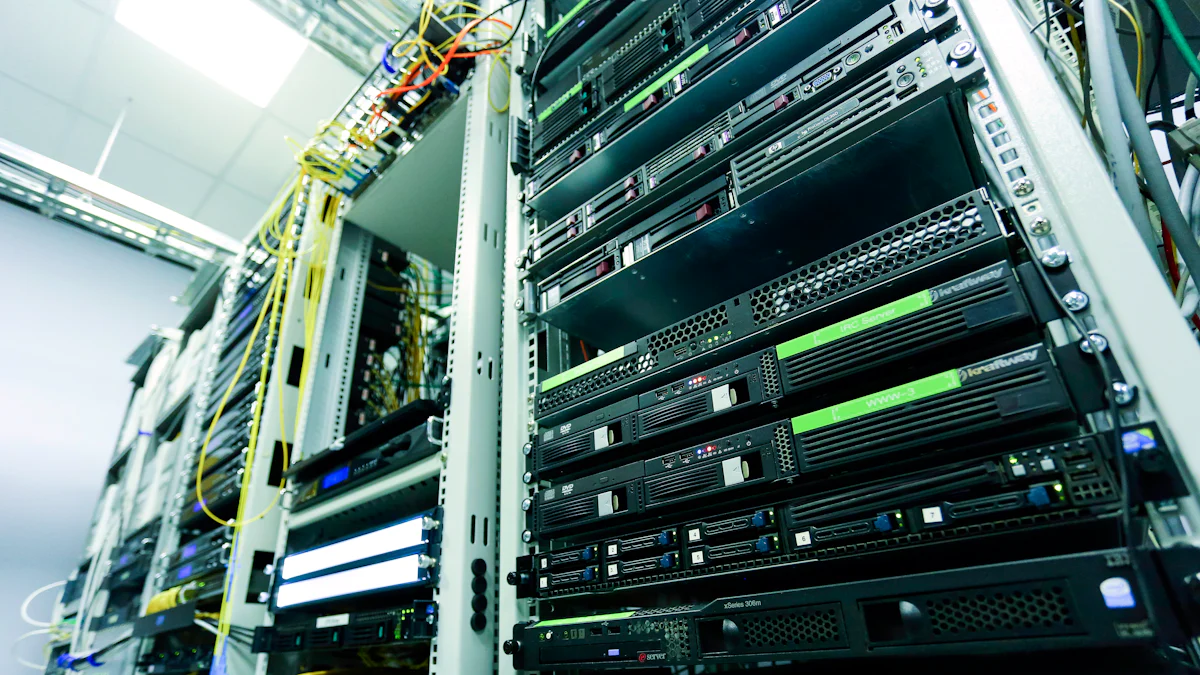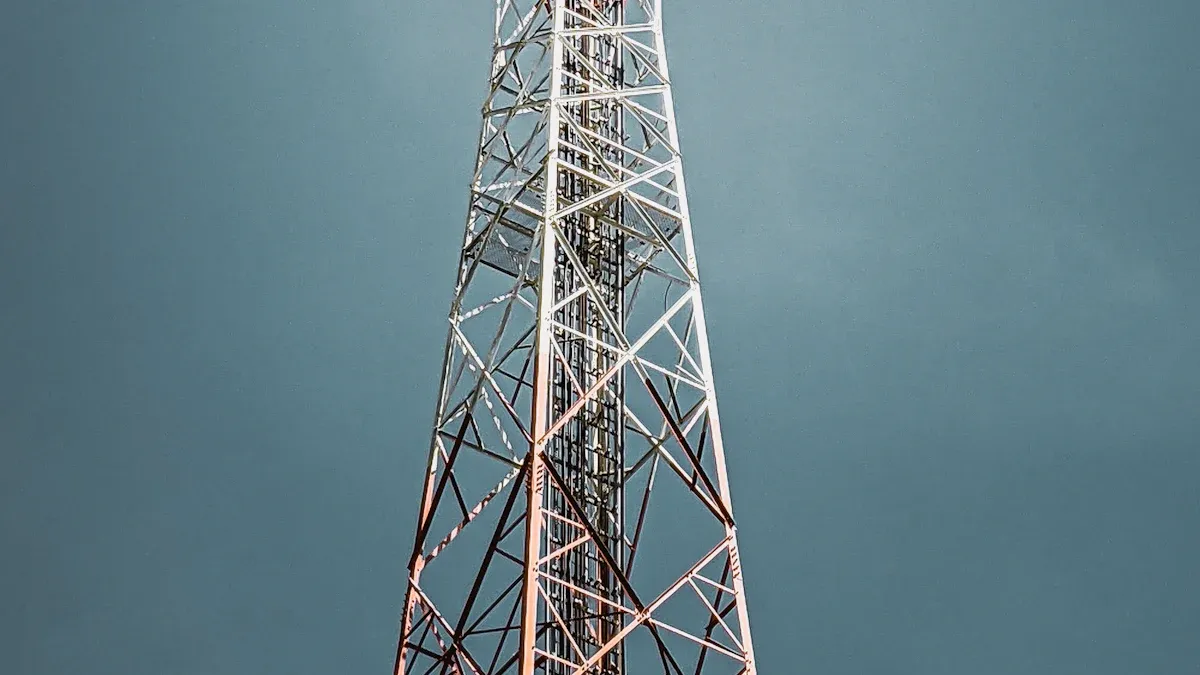What You Need to Know About DC Rectifier Systems for Telecom in 2025

A dc rectifier system converts alternating current into direct current, supplying telecom infrastructure with stable power for critical equipment. Telecom infrastructure depends on this technology to maintain uninterrupted service, especially as demand for reliable, efficient networks grows.
The global AC to DC converter market reached $15 billion in 2023 and is projected to hit $25 billion by 2032, with telecom infrastructure as a primary driver.
Three-phase systems support larger loads, ensuring reliability under heavy use.
Real-time monitoring and predictive analytics protect reliability.
Automation and fast alerts reduce downtime.
Scalable solutions adapt to growing telecom infrastructure needs.
Key Takeaways
DC rectifier systems convert AC power into stable DC power, which telecom equipment needs for reliable operation and uninterrupted service.
Modular and scalable rectifier designs allow easy upgrades and maintenance, supporting growing telecom networks and 5G expansion.
High efficiency and redundancy in rectifier systems reduce energy costs and downtime, improving network reliability and sustainability.
Remote monitoring and smart IoT features enable real-time system tracking, predictive maintenance, and faster response to issues.
Emerging trends like renewable energy integration, AI optimization, and advanced materials make DC rectifier systems more efficient and eco-friendly.
DC Rectifier System Basics
What Is a DC Rectifier System
A dc rectifier system forms the backbone of modern telecom infrastructure. This system converts alternating current from the utility grid into direct current, which telecom equipment requires for stable operation. The dc rectifier system includes several key components: rectifier modules, controllers, batteries, and power distribution units. Each part plays a specific role in ensuring that telecom infrastructure receives reliable dc power.
Rectifier modules handle the conversion of AC to DC power and maintain battery charge. These modules focus on efficiency, redundancy, and modularity.
Controllers serve as the logic center. They manage rectifiers, batteries, and distribution, while also providing network communication for monitoring.
Batteries, such as VRLA, Lithium Ion, NICAD, or Wet Cell types, supply backup power. They are often arranged in series to meet the demands of telecom applications.
Power distribution units deliver dc power to various telecom equipment, ensuring each device receives the correct voltage and current.
A dc rectifier system often operates as part of a larger dc power system or dc plant system. These systems support scalability and reliability, which are essential for telecom infrastructure. Engineering analyses from large Internet-hosting companies have compared centralized dc power plants with distributed battery-less dc-rectifier systems. These studies emphasize the importance of redundancy, fault tolerance, and scalability in telecom power systems.
Note: DC/DC converters play a critical role in maintaining stable output voltage, even when input conditions fluctuate. They enhance power conversion efficiency and provide galvanic isolation, which protects sensitive telecom equipment.
Why Telecom Needs DC Power
Telecom infrastructure depends on dc power for several reasons. Most telecom equipment, including routers, switches, and transmission devices, operates on dc power. This requirement stems from the need for stable, noise-free power that supports continuous operation.
DC power systems reduce the risk of power interruptions, which can disrupt telecom services.
Battery backup in dc power systems ensures that telecom infrastructure remains operational during utility outages.
DC power allows for precise voltage regulation, which protects sensitive equipment from damage.
Case studies highlight the importance of dc power in telecom applications:
AT&T's emergency-recovery dc-power system enabled rapid restoration of telecom service after a power failure. This example demonstrates the practical value of a robust dc rectifier system for critical telecom infrastructure.
Nortel Networks relied on surface-mount DC/DC power converters for optical networking equipment. This approach underscores the central role of dc power conversion technology in telecom hardware.
A telecom dc power supply must deliver consistent performance under varying load conditions. The design of dc power plants and dc power systems emphasizes scalability, reliability, and integration with communication networks. These features support the growing demands of telecom applications and ensure uninterrupted service.
Telecom infrastructure continues to evolve, but the need for a dependable dc rectifier system remains constant. The right dc power system supports both current and future telecom applications, making it a vital component in any telecom network.
Telecom Rectifier Architecture

Telecom rectifier architecture forms the backbone of modern telecom infrastructure. This architecture consists of several key components that work together to deliver reliable dc power to critical telecom equipment. Each component plays a distinct role in ensuring efficiency, safety, and uninterrupted operation.
Rectifier Modules
Rectifier modules serve as the primary building blocks in telecom rectifiers. These modules convert alternating current from the utility grid into stable dc power, which telecom infrastructure requires for continuous operation. Modern rectifier modules, such as those found in the NetSure 2000 series, achieve efficiency levels greater than 95%. High-density designs allow these modules to deliver up to 5800 watts and 200 amps, supporting large-scale telecom deployments. Modular construction enables easy scalability, allowing telecom operators to add or replace modules without disrupting service. Advanced protection features, including overvoltage, overcurrent, and thermal safeguards, enhance safety and system reliability. Soft-switching and power factor correction technologies further improve efficiency and reduce energy losses, making these rectifiers ideal for demanding telecom environments.
Feature/Metric | Matrix-Type PFC Rectifier Prototype (8 kW) |
|---|---|
Efficiency | 99.0% at nominal conditions |
Power Density | 4 kW/dm³ |
Semiconductor Technology | 900 V SiC MOSFETs |
Switching Technique | Soft switching modulation scheme |
Transformer | Integrated inductor for size reduction |
This table highlights how advanced rectifier modules combine soft-switching and high-performance semiconductors to achieve ultra-high efficiency and compact size.
DC-DC Converters
DC-DC converters play a vital role in telecom rectifiers by regulating output voltage and providing galvanic isolation. These converters ensure that telecom infrastructure receives the precise voltage required for sensitive equipment. Vertiv NetSure systems integrate intelligent DC-DC converters, which contribute to high efficiency and reliability. Third-harmonic injection modulation reduces ripple and RMS current in capacitors, allowing for smaller component sizes and improved power density. Advanced protection features in these converters guard against voltage spikes and short circuits, enhancing safety for both equipment and personnel. DC-DC converters also support flexible voltage ranges, making them suitable for diverse telecom applications.
Feature/Metric | Three-Phase Buck-Type PFC Rectifier (400 V DC) |
|---|---|
Efficiency | Up to 98.8% (prototype verified) |
Power Factor | Unity (close to 1) |
Loss Optimization | Semiconductor and parasitic capacitance losses modeled and minimized |
Voltage Range | Wide output voltage control down to low voltages |
Application | Telecom and data center power distribution |
Advantage over Boost-Type Topology | Better current limitation during output short circuit |
This table demonstrates that advanced DC-DC converters in telecom rectifiers achieve high efficiency and power factor, which are essential for reliable telecom infrastructure.
Battery Backup
Battery backup systems provide critical resilience in telecom rectifier architecture. These systems supply dc power during utility outages, ensuring that telecom infrastructure remains operational. Modern battery technologies, such as VRLA and lithium-ion, offer high energy density and long service life. Intelligent battery management units monitor charge and discharge cycles, optimizing performance and extending battery lifespan. Advanced protection features, including temperature monitoring and fault detection, safeguard both the battery and connected equipment. Safety remains a top priority, with enclosures designed to prevent accidental contact and contain potential hazards. Battery backup systems integrate seamlessly with rectifier modules and DC-DC converters, forming a unified dc power supply for telecom rectifiers.
Power Distribution
Power distribution units (PDUs) deliver dc power from rectifier modules and battery backup systems to various telecom devices. These units ensure that each piece of equipment receives the correct voltage and current, supporting stable operation across the telecom infrastructure. Integrated distribution modules, as seen in the NetSure 8000 series, provide modular and scalable solutions for large installations. Advanced protection features, such as circuit breakers and surge suppressors, enhance safety and prevent damage from electrical faults. High power density and compact design allow PDUs to fit within limited space, supporting the growing demands of modern telecom networks. Intelligent monitoring capabilities enable real-time tracking of load conditions and rapid response to anomalies.
Control and Monitoring
Control and monitoring systems represent the intelligence behind telecom rectifiers. These systems manage rectifier modules, DC-DC converters, battery backup, and power distribution units, ensuring coordinated operation. Intelligent controllers, like those in Vertiv NetSure architectures, provide remote access, real-time data analytics, and predictive maintenance alerts. Operators can monitor system health, track efficiency metrics, and respond quickly to potential issues. Advanced protection features, including automated shutdown and fault isolation, further enhance safety and reliability. Control systems support integration with network management platforms, enabling centralized oversight of telecom infrastructure. The combination of automation, analytics, and remote management ensures that telecom rectifiers deliver uninterrupted dc power under all conditions.
Note: Advanced telecom rectifier architectures now incorporate rectiverters—bidirectional modules that function as both rectifier and inverter. This innovation supports flexible dc power flows, energy storage integration, and seamless backup transitions, further enhancing efficiency and safety in telecom infrastructure.
How Telecom Rectifiers Work
AC to DC Conversion
Telecom rectifiers begin their operation by converting alternating current from the utility grid into direct current. This process starts when the rectifier receives AC input and channels it through a transformer. The transformer adjusts the voltage to the required level for telecom rectifiers. Next, the rectifier uses diodes and switching devices to convert AC into DC. Simulation studies using PSIM software show that a switched AC-DC boost converter achieves a dynamic response and stable output voltage, even when the load changes. Experimental testing confirms that telecom rectifiers can reach up to 85.2% efficiency and a power factor of 0.9, which means they deliver efficient power with minimal losses. Hardware setups validate these results, showing that telecom rectifiers can maintain power quality and reliability. Full-wave rectifiers and DC-DC converters work together to create a stable dc power supply for telecom systems.
Voltage Regulation
Voltage regulation ensures that telecom rectifiers deliver a consistent and stable dc power supply to sensitive telecom equipment. The rectifier uses voltage regulators, filters, and control circuits to maintain a steady dc voltage, even if the input or load fluctuates. Power filters remove noise and harmonics, which protects equipment from electrical disturbances. Built-in protections, such as under-voltage and over-voltage safeguards, prevent damage and maintain stable operation. Telecom rectifiers often achieve efficiency levels above 97%, which reduces energy loss and supports reliable voltage delivery. Modular designs allow telecom rectifiers to scale and provide redundancy, further enhancing the stability of the dc power supply.
System Integration
System integration brings together all components of telecom rectifiers to ensure seamless operation. The rectifier works with battery backup, DC-DC converters, and power distribution units to form a unified system. Intelligent controllers monitor the rectifier’s performance, manage alarms, and provide real-time data for proactive maintenance. Remote monitoring allows operators to track the status of telecom rectifiers and respond quickly to any issues. This integration guarantees that telecom rectifiers deliver a stable dc power supply, supporting uninterrupted telecom services. The combination of advanced hardware and intelligent software makes telecom rectifiers essential for modern telecom networks.
Benefits and Selection
Efficiency and Reliability
Telecom rectifiers deliver high efficiency and reliability, which remain essential for modern telecom networks. Most rectifier modules achieve efficiency ratings between 90% and 97%, with future designs targeting nearly 98%. High efficiency reduces energy loss and operational costs, supporting sustainable operations. N+1 redundancy configurations ensure continuous power, even if one rectifier module fails. This redundancy minimizes downtime and strengthens network reliability. Operators report a 30% reduction in energy consumption and a 25% decrease in downtime after deploying high efficiency telecom rectifiers. The table below summarizes key performance statistics:
Performance Aspect | Statistic | Explanation |
|---|---|---|
Efficiency | 90–97% | Reduces energy loss and costs |
Reliability | N+1 redundancy | Ensures continuous power |
Downtime Reduction | 25% | Improves network reliability |
Scalability and Modularity
Telecom rectifiers support scalability and modularity, which allow networks to expand as demand grows. Modular designs enable easy upgrades and maintenance. For example, a system with 108 modules can deliver 432kW and 8100A output, meeting high power demands. Modular telecom rectifiers simplify installation and maintenance, reducing service disruptions. The widespread adoption of these systems in Asia-Pacific, where 52% of expansions use high efficiency rectifiers, demonstrates their scalability.
Remote Monitoring
Remote monitoring has become a standard feature in telecom rectifiers. Digital control systems now appear in 34% of new rectifier deployments, providing real-time diagnostics and predictive maintenance. Operators can track efficiency, reliability, and system health from any location. Remote monitoring reduces the need for on-site visits and enables faster response to issues. This capability supports operational efficiency and network reliability.
Choosing the Right System
Selecting the optimal telecom rectifier system involves evaluating efficiency, reliability, scalability, and remote monitoring features. DC rectifier systems offer higher reliability and availability than AC UPS systems, with availability rates over 20 times greater. The universal 48-V standard in DC systems simplifies safety and maintenance. DC rectifiers provide galvanic isolation and battery filtering, protecting telecom equipment from power disturbances. Maintenance remains simpler due to uniform grounding and fewer battery cells. Telecom operators should consider these factors, along with efficiency rating and modularity, to ensure the chosen rectifier meets current and future network needs.
Trends for 2025

Smart and IoT Features
Telecom rectifier systems in 2025 will feature advanced smart and IoT capabilities. Manufacturers now use materials like silicon carbide and gallium nitride to create compact, efficient rectifiers. These materials support higher performance and device miniaturization. The global semiconductor market is expected to reach $687 billion in 2025, driven by demand for energy-efficient power conversion in telecom infrastructure. AI technologies optimize design and manufacturing, enabling real-time monitoring and predictive maintenance. IoT-enabled rectifiers allow operators to forecast energy consumption and manage power dynamically. Integration with smart grids improves reliability and efficiency. These features support a wide range of telecom applications, from core networks to remote sites.
Sustainability
Sustainability remains a top priority for telecom rectifier systems. New designs achieve up to 30% reduction in energy consumption and 40% lower CO2 emissions. Operators report a 25% decrease in downtime, which improves network reliability. Companies like GreenConnect have deployed renewable-ready rectifiers with smart monitoring and hybrid power systems across hundreds of remote sites. These systems combine solar, wind, and advanced rectifiers to enhance sustainability and reduce costs. Regulatory frameworks, such as the European Green Deal and ITU's Connect 2030 Agenda, drive the adoption of sustainable practices. Telecom rectifier systems now play a key role in supporting green initiatives and meeting global sustainability targets.
Note: Digital twin technology and smart heat management further improve energy efficiency and extend rectifier lifespan.
5G and Edge Support
The rollout of 5G and edge computing creates new demands for telecom rectifier systems. AI and automation enable predictive maintenance and energy optimization, which are essential for supporting dense, distributed networks. Smart rectifiers provide real-time data for network planning and rapid response to changing loads. Hybrid power systems ensure reliable operation in remote or off-grid locations. Evolving architectures, such as rectiverters and distributed systems, offer flexible power flows and seamless integration with energy storage. These advancements support a broad range of applications, including 5G base stations and edge data centers. Telecom rectifier systems now deliver the reliability and efficiency required for next-generation network application.
DC rectifier systems remain essential for telecom networks in 2025. Understanding their components, architecture, and emerging trends helps future-proof infrastructure.
High efficiency up to 97.8% reduces costs and energy loss.
Modular designs support seamless upgrades and 5G expansion.
Integration with renewables and remote monitoring enhances sustainability and reliability.
Predictive maintenance and secure cloud platforms protect uptime and data.
Telecom professionals should evaluate current systems, consult experts, and stay informed about new advancements.
FAQ
What is the main function of a telecom DC rectifier system?
A telecom DC rectifier system converts AC power from the grid into stable DC power. This process ensures that telecom equipment receives reliable energy for continuous operation.
What makes modular rectifier systems important for telecom networks?
Modular rectifier systems allow operators to scale power capacity easily. They support quick maintenance and upgrades, which helps minimize downtime and adapt to changing network demands.
What features help modern rectifiers achieve high efficiency?
Modern rectifiers use advanced semiconductor materials, soft-switching technology, and power factor correction. These features reduce energy loss and improve overall system performance.
What role does remote monitoring play in rectifier systems?
Remote monitoring provides real-time data on system health and performance. Operators can detect issues early, schedule maintenance, and ensure uninterrupted telecom service.
What trends define DC rectifier systems in 2025?
Smart features, IoT integration, and sustainability drive innovation. Rectifier systems now support renewable energy, predictive maintenance, and seamless operation for 5G and edge computing deployments.
See Also
Key Features To Understand In Telecom Power Supplies
The Importance Of Upgrading Telecom Cabinets By 2025
An Introductory Guide To Telecom Power Supply Systems
Steps To Guarantee Consistent Power In Telecom Cabinets
Methods For Calculating Power Systems And Batteries In Telecom
CALL US DIRECTLY
86-13752765943
3A-8, SHUIWAN 1979 SQUARE (PHASE II), NO.111, TAIZI ROAD,SHUIWAN COMMUNITY, ZHAOSHANG STREET, NANSHAN DISTRICT, SHENZHEN, GUANGDONG, CHINA

